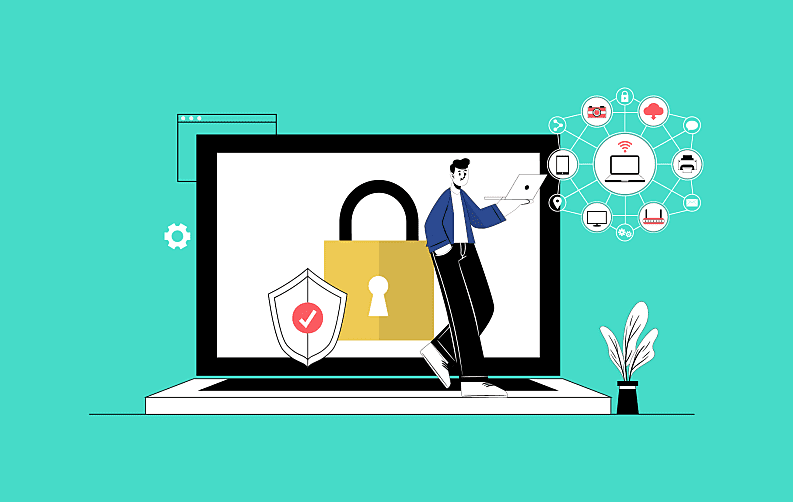
The widespread adoption of Internet of Things (IoT) devices in the ever-changing digital landscape is truly astonishing. Statista estimates a startling 15.14 billion IoT devices globally as we speed toward 2023, highlighting the widespread adoption of this cutting-edge technology in our daily lives. These gadgets have become essential due to their increased efficiency and affordability, which has led to increased productivity and better customer experiences globally. This vast network, however, has two drawbacks: in the era of interconnectedness, security and privacy are becoming increasingly important issues.
The integration of IoT devices into diverse systems creates an opening for cyber attacks, rendering vulnerable parties capable of exploiting weaknesses and jeopardizing confidential information. The danger doesn't end with virtual spaces; if these gadgets are physically stolen, sensitive data belonging to users may be accessed without authorization. Protecting these networked devices in the era of AI in cybersecurity requires a planned strategy that includes strong passwords, secure gateways, screen locks, and other security precautions.
As we examine the fundamentals of cyber security for IoT devices in the Internet of Things era, it becomes necessary to negotiate the complex terrain of technological innovation while keeping a close watch on securing the digital frontier.
Securing Your IoT Devices From Online And Physical Threats
The enormous amount of data that IoT devices create daily—5 quintillion bytes—seriously threatens privacy and security as their number soars. Statista estimates that there will be 50 billion connected devices by 2050. It's critical to fix multiple vulnerabilities in the cyber security for IoT devices that could jeopardize the integrity of cybersecurity in IoT devices to protect them from potential threats.
1. Poor authentication/authorization settings
Unauthorized access may be made possible by inadequate authentication and authorization procedures. For every device, create a strong, one-of-a-kind password. Whenever possible, use multi-factor authentication. Make sure that only authorized people can interact with your IoT devices by routinely reviewing and updating access permissions.
2. Unsecured connection protocols
Your IoT devices are susceptible to possible manipulation and interception when using insecure communication routes. To avoid illegal access and eavesdropping, encrypt data transmission using secure communication protocols like MQTT, CoAP, or HTTPS. Additionally, to establish a secure communication tunnel, consider putting a virtual private network (VPN) in place.
3. Lack of application updates
Outdated software is an ideal environment for flourishing network security and cyber security flaws. Regularly update your apps, software, and firmware and check for manufacturer updates and patches. Automated upgrades can expedite safeguarding your devices from the most recent IoT and cybersecurity risks.
4. Collection of data through unauthorized cookies
Unauthorized data gathering may put user privacy at risk in cyber security for IoT devices. Examine and adjust the privacy settings on your Internet of Things devices to prevent extraneous data from being collected. To reduce the chance of unwanted data collection, steer clear of devices that rely significantly on cookies and think about turning them off or switching to alternatives that prioritize privacy.
5. Hacking by cyber criminals
Cybercriminals are always changing their strategies. To protect your IoT devices from unwanted assaults, put strong IT and cyber security measures in place. These measures include firewalls, intrusion detection systems, and antivirus software. Watch for strange activity by reviewing device logs and network traffic to avoid IoT and cybersecurity attacks.
6. Device theft and authorized data access physically
Online security is not as important as physical security. To stop theft and unwanted access, physically secure your cyber security IoT devices. This entails putting electronics in safe places, locking them, and using security cameras or alarms to spot and prevent unwanted entry.
Keeping apps updated is one of the main safeguards against security breaches. Manufacturers frequently release updates to improve Internet of Things network security and fix vulnerabilities. Establish a routine of routinely updating the programs on your IoT devices to stay up to date with security patches and protect your hardware and data from attacks.
Use Passwords
Using passwords is essential if you want to strengthen the Internet of Things network security of your IoT devices. They serve as the main defense against unwanted access and protect private data. It's crucial to use strategic password practices to optimize their effectiveness:
- Create Complex Passwords: Don't use passwords that are simple to figure out. Create combos with a variety of letters, numbers, and special characters. Because of this intricacy, it is far more difficult for hackers to break into your passwords.
- Implement Multi-Factor Authentication (MFA): It is no longer adequate to rely only on one layer of password protection. Enforce multi-factor authentication to offer an extra degree of protection. This entails confirming one's identity using two or more authentication techniques, including security tokens, biometrics, or passwords.
- Utilize Lock Screens: Use lock screens to prevent unauthorized individuals' physical access to your devices. Locking the screens provides an additional line of defense by preventing possible risks from originating from unlawful handling of your devices.
Conduct Security Audits Regularly
Regular security audits are essential to bolstering your defenses against potential threats in the Age of the Internet of Things and cyber security due to the constantly changing techniques used by fraudsters in the dynamic cybersecurity landscape. Devices are frequently compromised without the user's knowledge, exposing systems and private information to abuse. You must incorporate regular security assessments into your IoT devices and cyber security strategy to protect against financial theft and illegal access.
These audits are a preventative step that evaluates how strong the security mechanisms included in your IoT devices are. They go beyond the surface to scrutinize critical areas that may otherwise go unnoticed to get protection from financial frauds. Among the important topics addressed in security audits are:
- Firewall Configuration and Safety: Analyze how well your device's firewall guards against harmful activity and prohibits unauthorized access. Make sure that the configuration complies with the most recent security requirements.
- Device Manager Settings: Check that the device manager's settings follow security best practices by carefully going over them. Verifying settings for program installations, device connections, and user privileges are all part of this process.
- Access Permissions Granted: Examine the permissions for access given to different individuals or apps. Ensure that no unused rights exist that may be abused and that only the appropriate permissions are granted.
- Strength of Access Controls and Protections: Evaluate how well the access controls in your IoT environment are working. This includes encryption techniques, user authentication systems, and other security precautions to prevent unwanted access.
- Identification of Possible Breaches or Dangerous Links: Use advanced techniques and tools to spot any indications of a security breach or potentially hazardous connections within your network. Proactive identification is essential to mitigate possible dangers before they escalate.
Understand The Current IoT Security And Privacy Threat Trends
With technology developing at a breakneck pace, new trends are also emerging, especially in the Internet of Things (IoT) space. Hackers, experts in crafting harmful apps intended to penetrate and compromise Internet of Things devices, are becoming more inventive as innovation advances. Consumers must keep up with the most recent advancements in IoT security because the modern digital landscape is full of hazards, from illegal access to data breaches.
Maintaining a constant state of alertness is essential for preventing potential vulnerabilities, particularly with new regulations and standards about the proper use of gadgets. The dynamic nature of the digital threat landscape is highlighted by the stark differences between the cybersecurity and privacy concerns faced three to five years ago and today.
Users must understand the nuances of IoT cybersecurity trends to navigate this ever-evolving landscape. By learning about common dangers and taking preventative action, people may strengthen their defenses against possible cyberattacks. To mitigate the dangers associated with the constantly evolving field of IoT security and ensure a robust and secure digital environment for users and their connected devices, it is imperative that one remains informed and takes the required actions.
Practice Wi-Fi And Internet Connection Hygiene
Hackers could use your Wi-Fi network as a weak point to access your devices without authorization. Enhance your cybersecurity by putting connection hygiene procedures into effect. The following three actions are crucial for improving network security:
1. Disconnect Devices When Not in Use
Disconnecting devices from your Wi-Fi network while not in use is a simple yet efficient way to secure it. Devices that are left connected could be vulnerable to cyberattacks and illegal access. You lower the attack surface and lessen the chance of exploitation by disconnecting them.
2. Utilize VPN for Secure Connections
Adding a Virtual Private Network (VPN) to your arsenal is a proactive way to improve online security. By encrypting your internet connection, a virtual private network (VPN) increases the difficulty of data interception by hackers. It also has the advantage of hiding your IP address and location, improving your online security and privacy. Use a VPN connection whenever you can to encrypt and safeguard all of your internet activity.
3. Exercise Caution with Public Wi-Fi
Public Wi-Fi networks are convenient, but serious security dangers are also associated with them. Cybercriminals frequently target these networks to breach user data and exploit weaknesses. Steer clear of public WiFi whenever you can. If you can't avoid it, establish a secure connection using a virtual private network (VPN) to encrypt your data and shield it from any risks that might be present on the public network.
Keep Your Hardware And Software Clean
Inadequate software and hardware can foster a virus-infested environment. You must continue to take precautions to guarantee the security of your systems. The following are crucial actions to maintain clean hardware and software:
- Utilize Antivirus Security: Use dependable antivirus software to build strong protection against possible dangers. By identifying and getting rid of harmful software, these tools can stop prospective attacks up to 99% of the time. Update your antivirus program often to ensure it can handle the newest dangers.
- Avoid Installing Suspicious Applications: When choosing and installing apps, proceed with caution. You should avoid installing an app if you have any doubts about its security. Rely on reliable resources, such as official app stores, to reduce the possibility of downloading dangerous applications.
- Exercise Caution with Emails, Links, and Documents: Exercise caution when working with emails, links, or documents—especially if they seem fishy. Since they can contain malware, avoid opening attachments and clicking on links from unidentified or unreliable sources. Put email screening measures in place to lessen the chance of harmful content in your inbox.
- Regularly Update Applications and Operating Systems: Update your operating system, software, and applications all regularly. Developers release security patches regularly to fix vulnerabilities. Set up automatic updates whenever possible to ensure your system is protected from new threats.
- Cleanse Your Gadgets of Junk Data: Ensure you regularly clear your devices of any extraneous information from the internet or apps. This entails uninstalling unnecessary apps, cleaning browser caches, and removing temporary files. In addition to improving device performance, routine maintenance lowers the possibility of security breaches.
- Utilize the Latest Operating System and Hardware: Ensure your devices' operating systems are up to date and compatible with the hardware on them. With each successive version, developers improve security features even further. Investing in the newest gear can help enhance security features and increase defenses against ever-changing online threats. Ensure you stay ahead of any vulnerabilities by routinely checking for updates and patches.
Conclusion
Vigilance and proactive actions are critical in navigating the complicated cybersecurity environment in the Internet of Things (IoT) era. Users need to understand how controversial cybersecurity is and always put their devices' security first. Understanding common risks and the consequences of an attack is a critical first step in developing a heightened awareness of potential weaknesses. Make data and device security your priority by choosing wise passwords and keeping your devices up to date to fend off possible breaches.
Adhering to excellent Wi-Fi and device interconnection hygiene strengthens your digital perimeter. In addition to the virtual world, make your smartphone physically safer by adding complex lock screen features that give you another line of protection against unwanted access. IoT-era cybersecurity requires a holistic strategy that combines physical and digital security measures to reduce threats efficiently. By following these fundamental guidelines, users may confidently traverse the IoT terrain, guaranteeing the robustness of their gadgets and the protection of confidential data.



















